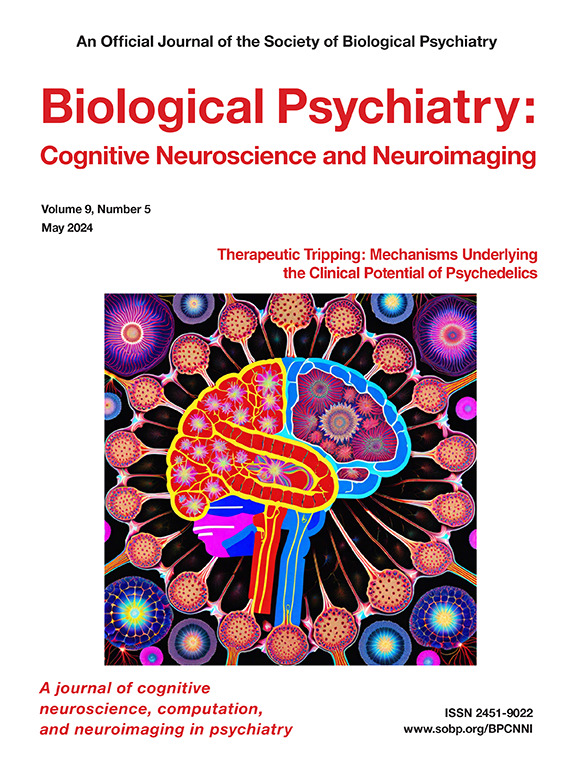重复负面思维患者接受工作记忆训练后静息状态功能连接的变化。
IF 5.7
2区 医学
Q1 NEUROSCIENCES
Biological Psychiatry-Cognitive Neuroscience and Neuroimaging
Pub Date : 2024-12-01
DOI:10.1016/j.bpsc.2024.04.017
引用次数: 0
摘要
背景:重复性消极思维(RNT)症状以普遍存在、无法控制的消极想法为特征,常见于情绪、焦虑和创伤应激障碍患者。无法调节工作记忆的内容是 RNT 的一个假设病因,这表明改善工作记忆的训练可能是有益的。本研究探讨了工作记忆训练对 RNT 升高患者静息状态功能连接(rsFC)的影响,以及这种变化是否与临床改善相关:我们对作为工作记忆训练干预随机对照试验[NCT04912089]一部分所收集的静息状态前数据(42 人)与等待对照组(23 人)进行了二次分析。我们假设,完成训练的个体将在两个关键的内在连接网络--默认模式网络(后扣带回皮层;PCC)和顶额叶网络(背外侧前额叶皮层;dlPFC)之间显示出更高的rsFC。我们探讨了 rsFC 的变化幅度是否与 RNT 症状严重程度的变化有关。结果:与候补表相比,训练组 PCC 与包括额叶和顶叶皮层在内的区域之间的 rsFC 增加了。PCC与上额叶皮层之间连接的增加与RNT症状的减轻有关:这些数据证明,工作记忆训练可以调节RNT患者静息状态下的神经回路。这些结果与工作记忆训练对大规模神经回路变化产生影响的说法一致,并表明这些变化可能有助于实现此类干预对跨诊断 RNT 症状的临床前景。本文章由计算机程序翻译,如有差异,请以英文原文为准。
Change in Resting-State Functional Connectivity Following Working Memory Training in Individuals With Repetitive Negative Thinking
Background
Repetitive negative thinking (RNT) symptoms, which are characterized by pervasive, uncontrollable negative thoughts, are common in individuals with mood, anxiety, and traumatic stress disorders. Inability to regulate the contents of working memory is a hypothesized etiological factor in RNT, which suggests that training to improve working memory may be beneficial. This study examined the effects of working memory training on resting-state functional connectivity (rsFC) in individuals with elevated RNT and whether such changes would be associated with clinical improvement.
Methods
We conducted a secondary analysis of pre-post resting-state data collected as part of a randomized controlled trial (NCT04912089) of working memory training interventions (n = 42) compared with a waitlist control group (n = 23). We hypothesized that individuals who completed training would show increased rsFC between the 2 key intrinsic connectivity networks—the default mode network (posterior cingulate cortex) and the frontoparietal network (dorsolateral prefrontal cortex). We explored whether the magnitude of rsFC change was associated with change in RNT symptom severity.
Results
rsFC increased between the posterior cingulate cortex and regions including the frontal and parietal cortex in the training group compared with the waitlist group. Increased connectivity between the posterior cingulate cortex and superior frontal cortex was associated with RNT symptom reduction.
Conclusions
These data provide evidence that working memory training can modulate neural circuitry at rest in individuals with RNT. Results are consistent with accounts of working memory training effects on large-scale neurocircuitry changes and suggest that these changes may contribute to clinical promise of this type of intervention on transdiagnostic RNT symptoms.
求助全文
通过发布文献求助,成功后即可免费获取论文全文。
去求助
来源期刊

Biological Psychiatry-Cognitive Neuroscience and Neuroimaging
Neuroscience-Biological Psychiatry
CiteScore
10.40
自引率
1.70%
发文量
247
审稿时长
30 days
期刊介绍:
Biological Psychiatry: Cognitive Neuroscience and Neuroimaging is an official journal of the Society for Biological Psychiatry, whose purpose is to promote excellence in scientific research and education in fields that investigate the nature, causes, mechanisms, and treatments of disorders of thought, emotion, or behavior. In accord with this mission, this peer-reviewed, rapid-publication, international journal focuses on studies using the tools and constructs of cognitive neuroscience, including the full range of non-invasive neuroimaging and human extra- and intracranial physiological recording methodologies. It publishes both basic and clinical studies, including those that incorporate genetic data, pharmacological challenges, and computational modeling approaches. The journal publishes novel results of original research which represent an important new lead or significant impact on the field. Reviews and commentaries that focus on topics of current research and interest are also encouraged.
 求助内容:
求助内容: 应助结果提醒方式:
应助结果提醒方式:


